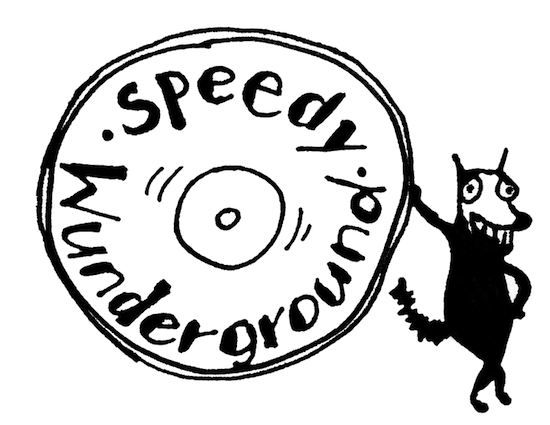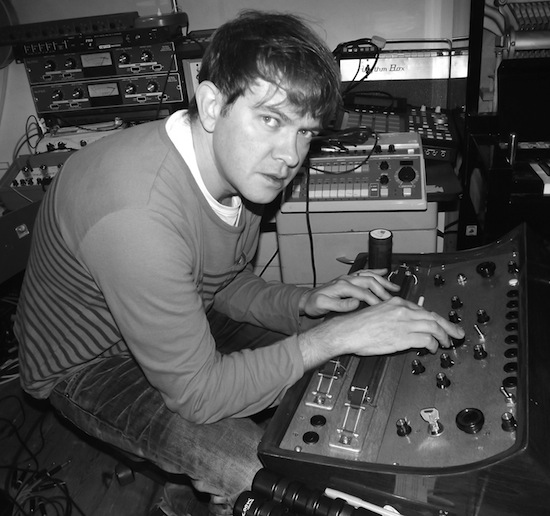“When you’re recording something, there’s a moment that comes just after everyone having learnt the song enough to be able to play it, where it just sounds amazing, because it’s slightly on edge, because no one’s 100% sure – I want to record that bit,” says Dan Carey. “Not the bit once it’s been rehearsed and played and played. It could be better once it’s been gigged for a while and turned into a real thing, but it’s that moment where everyone’s like ‘oh, shit!’”
Carey is talking about the guiding idea behind his new label, Speedy Wunderground. The producer, whose pretty all-encompassing credits list includes work with Toy, Bat For Lashes, Kylie Minogue, Franz Ferdinand, Tame Impala among others is launching the label as a means of cutting a record when the music is at that initial, mercurial stage of coming straight out of the artists’ brains, and cutting out the lengthy process of a record company churning over the release. Speed, as the name implies, is of the essence here.
The plan is for Carey and his engineer Alexis Smith to record the track in their Streatham, London studio on one day, mix and master it over the following days and then send it off to the printing plant to have a brand new 7” hot off the press within a week or two of the band laying down the track.
And the first song is in the bag – have a listen to ‘I Go Out’, a collaboration between Steve Mason, Emilíana Torrini and Toy, set for release on February 25, below. It’ll be available from the label’s website here, though you’ll need to be, ahem, speedy, about it as it’s limited to 250 copies worldwide.
The track’s something of a psyched-out motorik behemoth, which will play out over both sides of the 7” on release. Building first on Mason and Torrini’s traded verses, all the time gilded by Toy, in backing band mode, unfurling swathes of strings and a reined-in storm of feedback. We reach halfway point – the swoosh that marks where the sides split – before it returns, torrential, the colossal wall of noise toppling forwards, colliding with the relentless rhythm of the bass and drums.
Explaining the background of the track, Carey says: “It was a song that Steve had done an electro-style demo of when he was doing Black Affair and hadn’t used it. When he played it to me, I heard it with a different beat and bass line, and more psych, so it seemed like a good song to start with.
“To keep an element of surprise, I didn’t play the song to anybody before the recording day. On that day, we listened to it once, wrote down the lyrics and played round it for a few hours, trying things out until it settled at its new tempo and tone, trying not to refer back to the demo. The middle eight was something that emerged half way through the day. As planned, once everyone had a pretty good idea of what was going on, we put on the smoke and lasers and recorded five takes back to back.”
Turning back to the initial spark of the idea, Carey explains: “It’s a way to avoid the frustrating wait in between doing something that you think is the coolest thing ever and it eventually coming out, because I’ve had some experiences where we’ve made something, we’re really in love with it, and I have to wait nearly a year before it actually gets released, and you’ve mentally gone on to something else, so it’s not as exciting.
“We just thought that it would be good to be able to do stuff, and while it’s fresh a) not have a chance to go and change it, because of any pressure from what other people think and b) have it available to anyone right when it’s fresh in our minds.”
This lack of pressure also takes some burden of the creative aspect: “If we decided on the day to do something really weird, as long as that’s a mutual decision and everyone is involved in making it,” Carey adds, “then you don’t have to justify it to anyone.”

Stemming from the fact that its founder is also its in-house producer, who has an entire studio’s worth of kit permanently at his disposal, along with Carey and Smith’s expertise and willingness to be inventive with recording technique (lasers, smoke – see below) and an ever-morphing roster of ace bands, the label has more than enough scope to make brilliant records, while being simultaneously, in Carey’s words, “just for fun and for the sake of music”. Pointing at the grinning canine in the label’s logo, he adds: "I want to look like that dog at the end of the day!”
The first set of artists down to cut tracks features a number of previous Carey collaborators – he produced Toy’s album last year, has worked with Torrini on a number of records and recently started producing for Steve Mason – with Archie Bronson, Baxter Dury and Django Django all on the list for forthcoming Speedy Wunderground releases.
There’s also a plan to put a dub version of the track on the b-side (though this is always liable to change – says Carey "on the day I changed my mind for this song, because I was enjoying the repetition of the groove so much, I thought I’d rather have four minutes of that on the b-side than a dub"), with all of the material collected on an end-of-year compilation, which may get a release across CD, vinyl and download.
To focus the recording process, Carey and Smith have drawn up a list of guiding principles, a ten-point plan for Speedy Wunderground, which runs as follows:
- Speedy Wunderground is a new label which begins on February 25th with the release of I Go Out by Steve Mason & Emiliana Torrini.
- Speedy Wunderground is the idea of producer Dan Carey. Dan will produce all releases. All records will be recorded at Dan’s South London studio. Dan has previously produced Franz Ferdinand, Bats For Lashes, TOY, Willy Mason, Django Django, Emiliana Torrini, The Kills, Chairlift and Steve Mason.
- Recording of all records will be done in one day and finish before midnight. The recordings will be a snapshot of the day. Mixing will be done the day following the recording, also in one day only. This will prevent over-cooking and ‘faff’.
- There will be no lunch break during recording and mixing days.
- Overdubs will be kept to a minimum allowing the recordings to be free of clutter.
- The recordings will appear in limited runs of two hundred and fifty 7”s, which will be in the shops as soon as humanly possible following their completion.
- The core of each song will be a live take recorded in the dark with smoke and lasers and somewhere on each record the Swarmatron will make an appearance.
- Speedy Wunderground work quickly. There will be as a little delay as possible between recording and release. Speedy Wunderground records will not sit on the shelf gathering dust waiting to be released.
- Speedy Wunderground will release each year’s recordings as a compilation at the end of the year.
- Speedy Wunderground Records will not be slow.
Point number seven may well turn out to be the key tenet for the label. When recording Toy’s album last year, to try and recreate the atmosphere at one of their live shows, Carey suggested filling a darkened room with smoke and lasers. It’s the kind of technique that befits a studio where practical measures are taken to ensure a good recording – sleeping bags hang over the drum kit to improve the sound, while a metal coil strung across the entire ceiling provides some excellent reverb. And that’s not to mention the Swarmatron (again, see point seven) – an analogue synthesiser manipulated by a ribbon controller, hand-built by two cousins in Los Angeles, and the source of an otherworldly, endlessly-malleable ‘swarm’ of sound. Carey’s the owner of the sole Swarmatron in the UK – it’s the machine he’s manipulating amidst the plethora of other natty analogue gadgetry in the above picture.
Says Carey: “It’s not all about putting people out of context, but I’ll find something to make it unusual. I think for most people, recording in the dark in a smoke-filled room is quite unusual anyway. We did that with Toy – that’s kind of what started the obsession with weird… It was just so much fun. Every time I’d seen them play, there had been flashing lights and smoke, and it seemed weird doing it in the studio’s kind of light… so that’s when I bought some machines.”
The handy pay-off is that the recording process gives the label’s output a kind of in-built sonic signature. “The only thing is,” continues Carey, “we’ve discovered that it’s not very good for the equipment, so we’re not really sure what to do – I think it makes some of the switches a little crackly. Maybe that’ll be the sound of Speedy Wunderground.”


